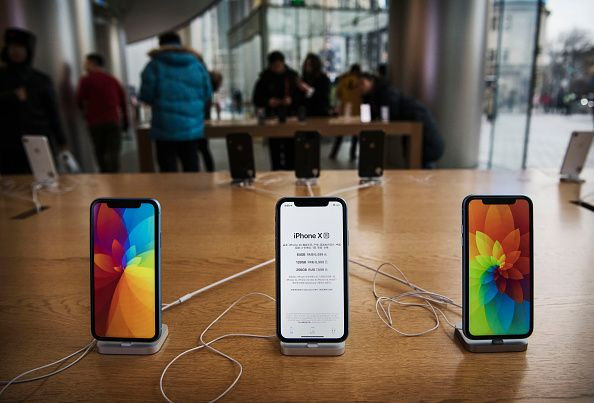These 2 Tech Giants Raised Prices At The Worst Time

Pricing power is one of the most powerful competitive advantages a company can have. The ability to raise prices without negatively affecting demand is the difference between a good company and a great company. Billionaire Warren Buffett has said that pricing power is the "single most important decision in evaluating a business."
Until recently, smartphone king Apple (NASDAQ:AAPL) and graphics chip leader NVIDIA (NASDAQ:NVDA) appeared to have no limit to their ability to push up prices. Apple had been successfully boosting its iPhone selling prices by introducing pricier models, and NVIDIA was using each new generation of its graphics chips to extract increasing amounts of cash from gamers.
But pricing power does have limits, as investors in both companies are now realizing.
People love iPhones, but only so much
Faced with a stagnating market for smartphones, Apple released the $999 iPhone X in 2017 as a way to push up prices and boost its revenue. It worked. Apple's iPhone average selling price soared, and revenue soared along with it. iPhone revenue jumped 18% in fiscal 2018, which ended in September, while iPhone unit sales were essentially flat.
Apple's demonstration of pricing power was impressive, but the company took it too far. Last year's batch of iPhones were even more expensive, with the high-end iPhone XS Max starting at $1,099. The cheapest new iPhone, the iPhone XR, started at $749. While iPhone users were eager to upgrade to the iPhone X, they weren't so eager to upgrade to Apple's even pricier phones.
Apple slashed its first-quarter revenue guidance in January, blaming slumping demand in China and lower-than-expected upgrade activity in developed markets. This came after Apple announced that it would stop disclosing iPhone unit sales starting in the first quarter. When a company stops disclosing important data, things often get ugly.
Apple had pricing power in a world where the smartphone market was growing, and where each new generation of phones brought significant improvements. That world doesn't exist anymore. Global smartphone sales are now in decline, and smartphones just aren't improving all that much year to year. This has led consumers to hold on to their phones for longer, a disaster for the iPhone-dependent Apple.
Gaming growth hits a brick wall
While NVIDIA's long-term potential centers around its data center and automotive businesses, gaming has been a major growth engine for the company over the past few years. NVIDIA has been the graphics card market leader for a long time, and its lead got bigger when it launched its GeForce 900 series GPUs back in 2014. The GeForce 10 series in 2016 cemented the company's advantage over rival Advanced Micro Devices.
NVIDIA's RTX 20 series, launched late last year, hasn't enjoyed the same success for a few reasons. First, demand for graphics cards had been elevated since early 2017 due to the cryptocurrency bubble. Graphics cards were being used to "mine" cryptocurrencies, creating shortages and pushing up prices. The bubble burst last year, and that demand has now vanished. Both NVIDIA and AMD are now working through excess inventory, which is severely depressing sales and pushing down prices of older graphics cards.
Second, NVIDIA aggressively boosted prices despite that inventory overhang. The RTX 20 series is expensive, and performance gains over the previous generation aren't particularly impressive. The midrange RTX 2060, for example, is a whopping 40% more expensive than its predecessor and delivers a 60% performance boost. For comparison, the GTX 1060 was just 25% more expensive than its predecessor and provided an 85% performance boost. It's not surprising that gamers aren't eager to upgrade.
NVIDIA was able to pass off higher prices with the GTX 10 series because those products delivered exceptional value. The RTX 20 series is a different story. NVIDIA's pricing power has reached its limit.
Tough roads ahead
With demand for iPhones weakening, Apple is now relying on its services businesses for growth. But many of its services depend on either iPhone sales or the iPhone user base. If iPhone revenue settles into a long-term decline, finding growth will be a monumental challenge for the company.
NVIDIA now faces a graphics card market that's normalizing after nearly two years of cryptocurrency-driven demand. AMD is launching a new high-end graphics card, and the high prices on the RTX 20 series all but guarantee that this generation won't trigger the same upgrade cycle the GTX 10 series did. NVIDIA's revenue is set to plummet in the first quarter, and a quick recovery looks unlikely.
Both Apple and NVIDIA have depended on raising prices to drive growth over the past couple of years. That strategy will no longer work for either company.
This article originally appeared in the Motley Fool.
Timothy Green has no position in any of the stocks mentioned. The Motley Fool owns shares of and recommends Apple and Nvidia. The Motley Fool has the following options: long January 2020 $150 calls on Apple and short January 2020 $155 calls on Apple. The Motley Fool has a disclosure policy.



















